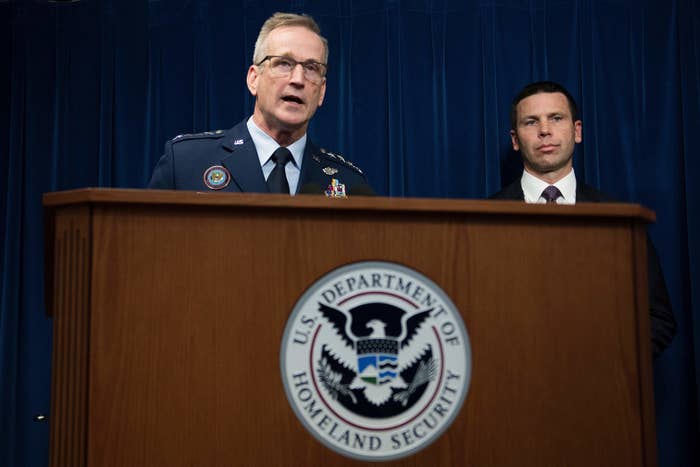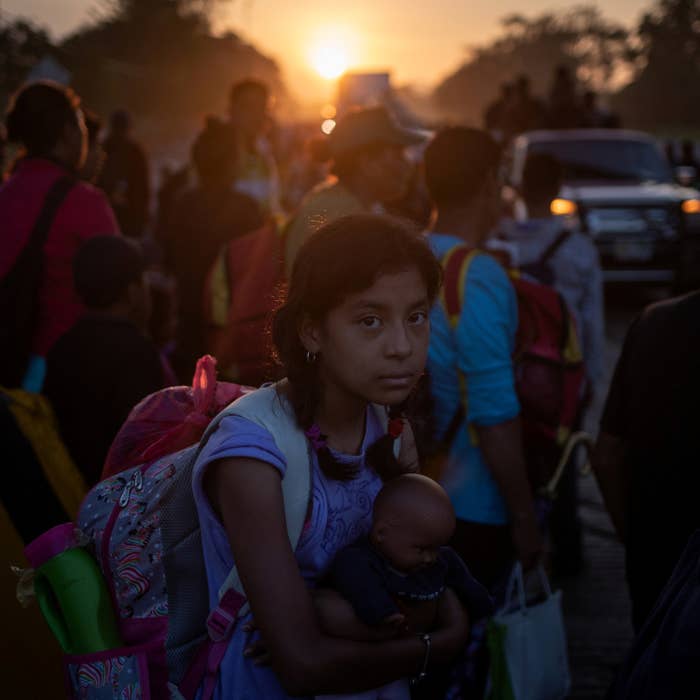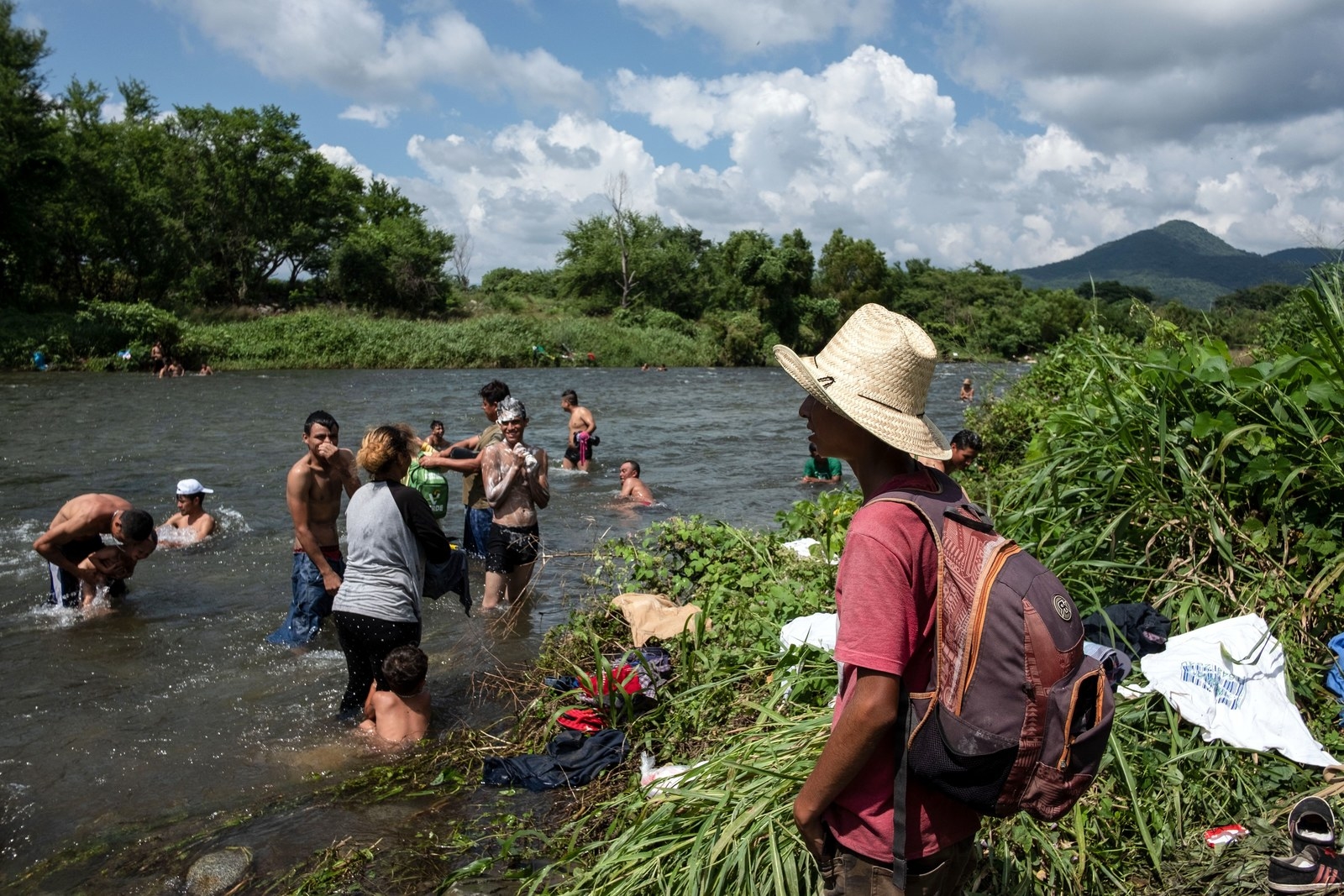
The US military on Monday announced it would soon have more troops deployed along the US–Mexico border than it has fighting extremists in Syria and Iraq.
Air Force Gen. Terrence O’Shaughnessy, the head of US Northern Command, announced that 5,200 troops would soon join 2,092 National Guard members who were deployed in April along the border, bringing the total number of US troops there to roughly 7,300.
That is more than are currently deployed to Iraq and Syria, where the US has 5,200 and 2,000 troops, respectively, and about half the US military presence of 15,000 in Afghanistan.
The troops would also outnumber the group of migrants moving toward the border by more than two to one. Two-thirds of those migrants are women and children.
“I think the president has made it clear that border security is national security,” O’Shaughnessy said at a press conference. He said an initial group of 800 troops had already been dispatched to Texas.
The active-duty troops deployed to the border will “harden the points of entry” in Texas, Arizona, and California working with US Customs and Border Protection, he said. They will include combat engineer battalions with experience building fencing, helicopter companies with aircraft equipped with night-vision capabilities, and members of the US Army Corps of Engineers. He emphasized that they would be stationed at ports of entry “in a support role” and assist with different projects including construction, medical aid, and aerial transport.
The troops are expected to be in place by the end of the week, O’Shaughnessy said. A spokesperson said the Pentagon was still determining the cost of the deployment.
O’Shaughnessy offered an unusually bellicose assessment of the deployment, given the long-standing portrayal of the US–Mexican border as one of the longest demilitarized frontiers in the world. He said the troops would deploy with 22 miles of concertina wire and would have 150 more miles of the razor-sharp material available. The US–Mexico border is 1,950 miles long.
Troops who normally are issued weapons would deploy with them, he said, though he did not say under what circumstance they would be allowed to fire them. A Pentagon spokesperson said the troops would use weapons only in self-defense.

“That is just the start of this operation,” he said. “We have the authority, given to us by Secretary Mattis — the units that are normally assigned weapons, they are, in fact, deploying with weapons.”
The Mexican foreign ministry said it had no comment.
The deployment is in response to a caravan of migrants that is currently traveling through southern Mexico and being tracked by the Defense and Homeland Security departments. The caravan now numbers about 3,500, half the number that set out from the Mexico–Guatemala border a week ago, though another group of 3,000 migrants is still in Guatemala, US officials said Monday. At least 1,000 members of the caravan have applied for asylum in Mexico, according to the Mexican government.
Defense Secretary Jim Mattis signed the order authorizing the deployment of troops to the border Friday after the Department of Homeland Security sent a formal request following the president’s increasingly forceful calls to stop the migrant caravan, making it a main talking point ahead of the upcoming midterm elections. The troops are authorized to remain at the border until Dec. 15.
As the deployment was being announced Monday afternoon in Washington, hundreds of troops had already arrived at the border, following days of mixed messages about the deployment’s size and its mission. Even as the Pentagon still refused to officially confirm the military mission, saying it was “premature to speculate total numbers” because planning was “still underway,” photos and videos appeared on the Defense Department’s media site showing and identifying units that, according to the caption, were departing to the border in support of “Operation Faithful Patriot.”

Soldiers with the 89th Military Police Griffin Brigade, who arrived last week for “Vigilant Shield” exercises at Fort Knox, Kentucky, seemed to have been quickly deployed to the border instead. Photos posted last week showing them arriving for the readiness exercises were edited on Saturday to include an update: “these soldiers have been placed on a prepare to deploy order to support Customs and Border Protection along the Southwest border.”
Troops deployed to the border will come from Fort Bragg in North Carolina, Joint Base Lewis–McChord in Washington state, Fort Stewart in Georgia, Fort Campbell and Fort Knox in Kentucky, and Fort Riley in Kansas, as well as other locations.
What the troops will be doing remained uncertain. US law prohibits the military from engaging in law enforcement activities. In the past, defense officials have referred to the role of guards at the border as a “force multiplier,” assisting with logistic, administrative, maintenance, and surveillance that frees more Border Patrol agents to go into the field. But the limitations on their actions are severe; for example, US troops are not allowed to surveil the Mexican side of the border when they’re monitoring camera footage.
After Trump called for sending US troops to the border in April, the head of the national Border Patrol union, which represents 15,000 agents, called their deployment “a colossal waste of resources” and said the union saw “no benefit.”
While the deployment of several thousand troops makes good on Trump’s threat to bolster the US military presence at the border ahead of next month’s midterm elections, military analysts and former defense officials expressed doubts that their presence is necessary. They note that the migrant caravan is composed primarily of people likely to seek asylum.
The additional troops will also not “close” the border, as the president tweeted last week.
....In addition to stopping all payments to these countries, which seem to have almost no control over their population, I must, in the strongest of terms, ask Mexico to stop this onslaught - and if unable to do so I will call up the U.S. Military and CLOSE OUR SOUTHERN BORDER!..
Ahead of Monday’s announcement of the military mission, Trump tweeted that “many gang members and some very bad people were mixed into the caravan,” and told them to turn around.
“This is an invasion of our Country and our Military is waiting for you!” he tweeted.
But a Pentagon spokesperson told BuzzFeed News that the current deployment would operate under a directive that Mattis issued in April that prohibits them from performing law enforcement activities or interacting with “migrants or other persons detained by [Department of Homeland Security] personnel.”
CORRECTION
The name of US Customs and Border Protection was misstated in an earlier version of this post.
